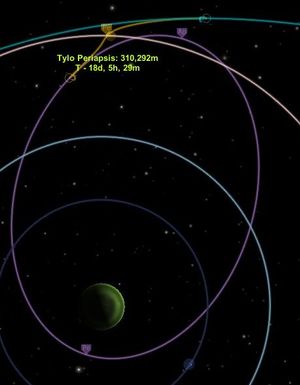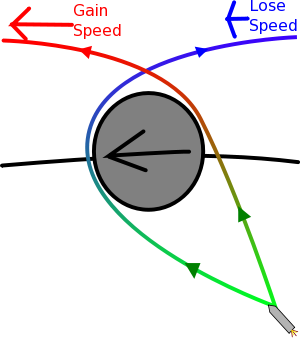Difference between revisions of "Tutorial: Gravity Assist"
Zombie Elvis (talk | contribs) m ("your") |
Zombie Elvis (talk | contribs) (made it a bit shorter with "satellite" and "primary". As for the repeated assists, the ESA did it IRL for Rosetta: http://i.imgur.com/TUkKuhf.gif) |
||
| Line 1: | Line 1: | ||
[[File:Gravitational slingshot.svg|right|thumb|Over-simplified example of gravitational slingshot: the spacecraft's velocity (v) changes by up to twice the body's orbital velocity (U).]] | [[File:Gravitational slingshot.svg|right|thumb|Over-simplified example of gravitational slingshot: the spacecraft's velocity (v) changes by up to twice the body's orbital velocity (U).]] | ||
| − | A '''Gravity Assist''' a.k.a. '''Swing-By''' or '''Slingshot''' is a very fuel-efficient method to change your [[craft]]'s speed and heading using the orbital velocity and gravity of a [[ | + | A '''Gravity Assist''' a.k.a. '''Swing-By''' or '''Slingshot''' is a very fuel-efficient method to change your [[craft]]'s speed and heading using the orbital velocity and gravity of a [[satellite]]. Every satellite orbits its [[primary]]. Whichever celestial body that your craft is currently in the [[sphere of influence]] of, that body's own orbital velocity is also influencing your craft. Satellites must have great orbital velocity in order to maintain that orbit around their primary. If you move from the primary's SOI that you're currently in to that of a [[satellite]] with an SOI (an orbiting planet or moon), you can use that satellite's orbital velocity and gravity to your own advantage to increase or decrease your craft's speed and change its heading much more efficiently than firing engines alone. |
| + | It's even possible to repeatedly use a body for a gravity assist, provided your previous assist doesn't end up escaping the primary's SOI. Repeated assists are most easily done by using planets. After the previous assist, you will most likely need to change your heading to encounter the satellite again. | ||
*'''Length:''' 30 minutes | *'''Length:''' 30 minutes | ||
Revision as of 17:49, 16 July 2015
A Gravity Assist a.k.a. Swing-By or Slingshot is a very fuel-efficient method to change your craft's speed and heading using the orbital velocity and gravity of a satellite. Every satellite orbits its primary. Whichever celestial body that your craft is currently in the sphere of influence of, that body's own orbital velocity is also influencing your craft. Satellites must have great orbital velocity in order to maintain that orbit around their primary. If you move from the primary's SOI that you're currently in to that of a satellite with an SOI (an orbiting planet or moon), you can use that satellite's orbital velocity and gravity to your own advantage to increase or decrease your craft's speed and change its heading much more efficiently than firing engines alone.
It's even possible to repeatedly use a body for a gravity assist, provided your previous assist doesn't end up escaping the primary's SOI. Repeated assists are most easily done by using planets. After the previous assist, you will most likely need to change your heading to encounter the satellite again.
- Length: 30 minutes
- Difficulty: Medium
- For version: 0.18.4
How to do it
In this example we will leave from Kerbin to a trajectory to Duna by performing a gravity assist around the Mun. Usually you need to raise your apoapsis to 85 million km to escape from Kerbin. With this method we will just have to get to the Mun orbit (12 million km). This will save you fuel for several hundred m/s of delta-v.
- Get your ship into a circular Low Kerbin Orbit
- Zoom out so you can see the orbit of Kerbin around the sun.
- Arrange for a fly-by with the Mun just like you learned in the "Going to the Mun" ingame tutorial, but arrange for it to happen while the Mun is heading into the direction you want to go. In this case we want to get further way from the sun, so do it when the Mun is going in that direction - the moment it intersects the orbit of Kerbin.
- Accelerate time until you reach the sphere of influence of the Mun
- Now plan another course correction maneuver. The maneuver is more effective when you are close, so try to pass the Mun as close as possible without colliding. Your Mun periapsis needs to be behind Mun on Muns trajectory. When you pass in front of Mun, you will lose speed instead of gaining it. Also watch the declination of your trajectory - when it gets too high it will be problematic.
- Accelerate time until you left the SoI of the Mun.
- When you check the map you will notice that you are on a much wider orbit than you were before the Mun fly-by (likely with an apoapsis beyond Minmus orbit), but it's not a Kerbin escape trajectory yet. The Mun hasn't yet given you all the speed it can.
- So perform another correction maneuver which leads you to another close Mun fly-by and again try to pass it as close as possible. The best moment to perform this maneuver is usually when you are furthest away from Mun.
Congratulations, you should now be on an orbit leading you in the general direction of Duna with plenty of fuel left for the return trip. When you want to go back, perform the same trick with Ike.
Reverse Gravity assist

Should you enter the Duna-Ike system in a suitable trajectory, you can perform a reverse-gravity-assist to lose speed instead of gaining it. To do so just do an Ike-fly-by. In order to lose speed instead of gaining it, your Ike periapsis needs to be in front of Ike's trajectory instead of behind it.
Powered Gravity assist
To get even more out of a gravity assist, you can perform a powered gravity assist. As you know, accelerating at your periapsis has the greatest effect on your apoapsis. This still applies to your periapsis during a gravity assist. When you accelerate during your fly-by, this fuel is used very efficiently to increase the apoapsis of your final trajectory. This is, however, a very difficult technique, because it is hard to control your final trajectory, even when using a maneuver node.
See also
- Using Gravity Assists To Save Fuel by Scott Manley on YouTube
- Gravity assist on Wikipedia

